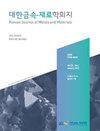Comparison of Weldability and Microstructure in Resistance Spot Welding of Aluminum 5052-H32 Alloy and Al 6014-T4 Alloy
IF 1.4
4区 材料科学
Q4 MATERIALS SCIENCE, MULTIDISCIPLINARY
引用次数: 0
Abstract
This study was performed to compare the resistance spot weldability of Al 5052-H32 alloy and Al 6014-T4 alloy, and the cause of the differences in the weldability was investigated. In general, the surface of the aluminum alloy has an oxide film several nm thick, and local heat input is generated at the electrode-sheet interface and the sheet-sheet interface during resistance spot welding. XPS analysis proved that the Al 5052- H32 alloy has a relatively thick magnesium oxide film on the surface and contains a large amount of magnesium solute element. As a result, Al 5052-H32 has a higher resistance, in both the contact resistance of the electrodesheet interface and sheet-sheet interface, compared with the Al 6014-T4 alloy. Therefore, the Al 5052-H32 alloy has a larger nugget diameter at the same welding current as compared to the Al 6014-T4 alloy, but the surface contamination of the electrode is aggravated due to local heat input. The results indicated that a difference in oxide film type and thickness can significantly influence resistance heat generation and electrode cooling effects, as well as produce welds with different weld morphology and microstructure. In addition, the Al 5052-H32 alloy had more pores and shrinkage in the weld than Al 6014-T4 alloy, and longitudinal cracks were observed in the center of the nugget, but had relatively excellent mechanical properties.铝 5052-H32 合金和铝 6014-T4 合金电阻点焊的焊接性和显微组织比较
本研究对 Al 5052-H32 合金和 Al 6014-T4 合金的电阻点焊性进行了比较,并探究了焊接性差异的原因。一般来说,铝合金表面有一层数 nm 厚的氧化膜,电阻点焊时在电极-薄板界面和薄板-薄板界面会产生局部热输入。XPS 分析证明,Al 5052- H32 合金表面有一层较厚的氧化镁膜,并含有大量的镁溶质元素。因此,与 Al 6014-T4 合金相比,Al 5052-H32 在电极板界面和板-板界面的接触电阻方面都具有更高的电阻。因此,与 Al 6014-T4 合金相比,在相同的焊接电流下,Al 5052-H32 合金的金块直径更大,但由于局部热输入,电极表面污染加剧。结果表明,氧化膜类型和厚度的不同会显著影响电阻发热和电极冷却效果,并产生不同焊接形态和微观结构的焊缝。此外,与 Al 6014-T4 合金相比,Al 5052-H32 合金在焊缝中具有更多的气孔和收缩,并在焊块中心观察到纵向裂纹,但具有相对优异的机械性能。
本文章由计算机程序翻译,如有差异,请以英文原文为准。
求助全文
约1分钟内获得全文
求助全文
来源期刊

Korean Journal of Metals and Materials
MATERIALS SCIENCE, MULTIDISCIPLINARY-METALLURGY & METALLURGICAL ENGINEERING
CiteScore
1.80
自引率
58.30%
发文量
100
审稿时长
4-8 weeks
期刊介绍:
The Korean Journal of Metals and Materials is a representative Korean-language journal of the Korean Institute of Metals and Materials (KIM); it publishes domestic and foreign academic papers related to metals and materials, in abroad range of fields from metals and materials to nano-materials, biomaterials, functional materials, energy materials, and new materials, and its official ISO designation is Korean J. Met. Mater.
 求助内容:
求助内容: 应助结果提醒方式:
应助结果提醒方式:


